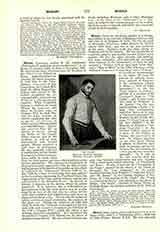

Moroni, GAETANO, author of the well-known “Dizionario di erudizione storico-ecclesiastica”, b. at Rome, October 17, 1802; d. there, 3 Novenber, 1883. He received his early education from the Brothers of the Christian School at Rome. Apprenticed later to a barber, his duties frequently took him to the Camaldolese convent of San Gregorio on the Coelian Hill; there the abbot, Mauro Cappellari, and several of the fathers recognized his exceptional gifts, and made use of him in a quasi-secretarial capacity. When Cappellari became a cardinal, he made Moroni his cameriere: and when he became pope, as Gregory XVI, he took Moroni for primo aiutante dicamera, employing him also as private secretary, in which capacity Moroni wrote over 100,000 letters. Moroni also served Pius IX as aiutante di camera. Among the books of the Camaldolese convent and of the cardinal, as well as from conversation with learned people. Moroni acquired a vast store of information. He also gradually collected a considerable private library bearing on ecclesiastical questions, while he made notes from the daily papers and from other publications for his own instruction. The subsequent arrangement of these notes in order suggested to him the idea of turning his labors to the benefit of the public, an idea which he realized in the “Dizionario” (Venice, 1840 61; index, 1878 9), a mine of interesting data and authoritative in matters concerning the Pontifical Court, the organization of the Curia and the Church, and the administration of the Pontifical States. In matters of history, it depends on the writers whom its author consulted. It is, however, not a well-ordered or homogeneous work; but these defects may be readily forgiven in view of the fact that its author did his work alone, without real collaboration, and wrote at times sixteen hours a day. He was also the author of official articles on papal ceremonies, the journeys of the popes, etc. During the conclaves of 1829 and 1831, he wrote the “Giornale storico-politico-ceremoniale della sede vacante e it conclave per l’elezione di Pio VIII e Gregorio XVI”, which, like others of his writings, remained unpublished. As a member of the household of Gregory XVI, Moroni was the object of much sectarian hatred. He was a friend of many car-dinals, including Wiseman, and of other illustrious men. In the index of the “Dizionario” (s.v., Moroni), he indicates the various passages of the work in which he speaks of himself, and which thus constitute a kind of autobiography.
U. BENIGNI

